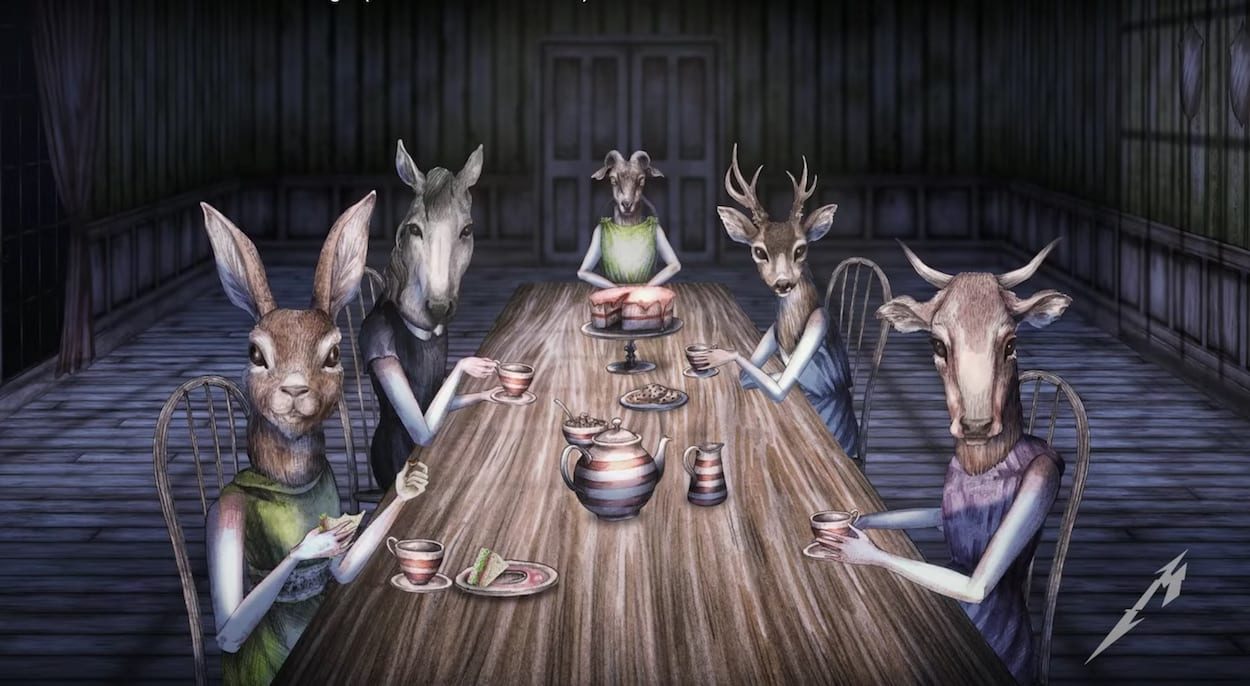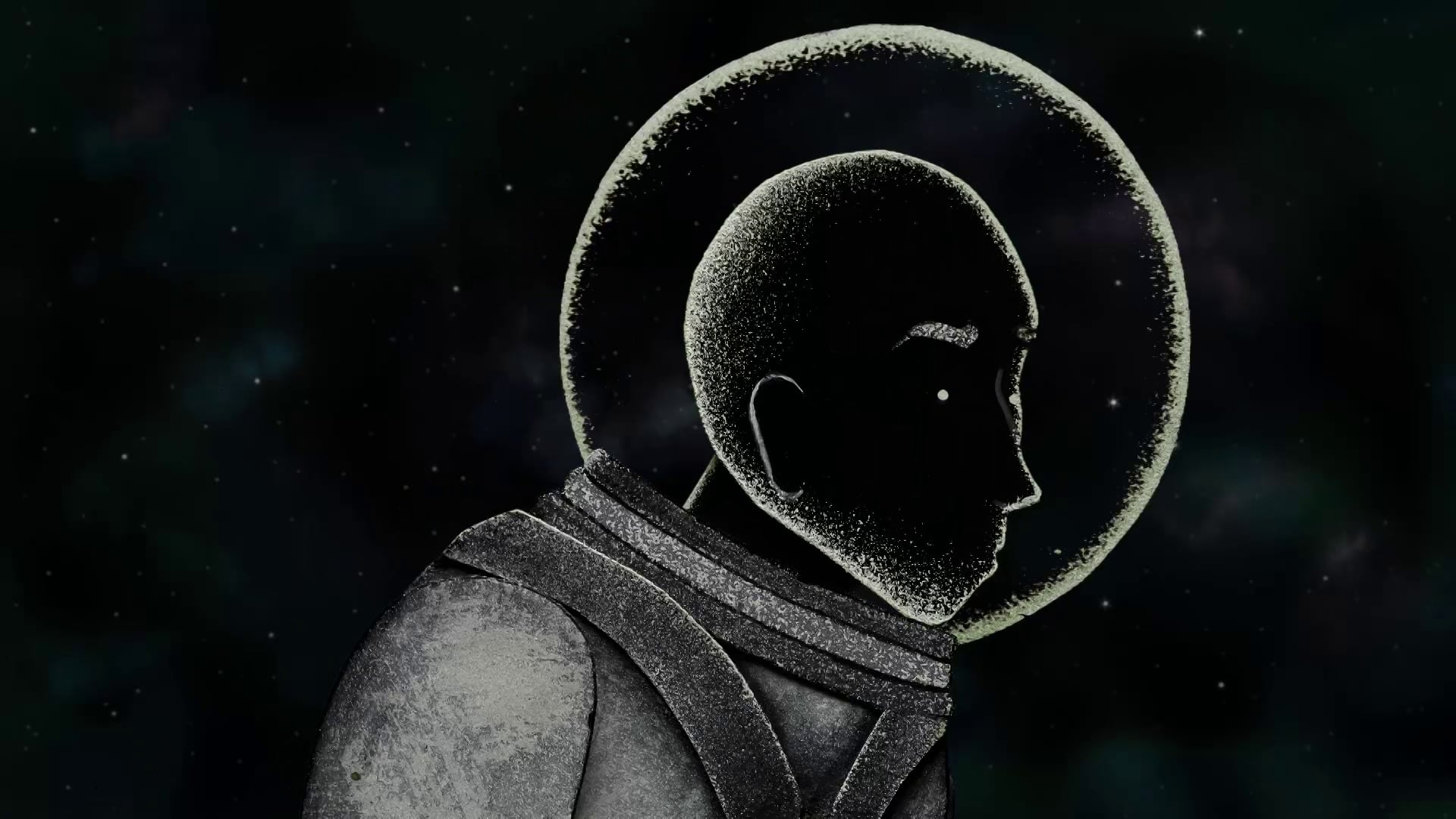Please tell us how the project came about and what was the brief – did Metallica have a storyline or did you create the narrative in response to the band’s lyrics? How closely did you collaborate with the band throughout the process of making the video?
I’d been in touch with Robert Trujillo for quite some time and there had been a lot of discussions about working on something together in the future. At the time the new Metallica album was soon to be launched. He suggested maybe I could direct one of the music vids, so I did!
The song is about a real serial killer who murdered a fan after a Metallica gig. I knew I had to base my idea around this theme but I wanted to totally disconnect it from the real story. After talking it through with my very good friend Adam Oehlers (the illustrator) we came up with a really dark idea pretty quickly. I didn’t have any contact really with any of the other members of the band besides Robert. He would keep me in the loop and send me encouraging emails and messages about what the band were thinking with regards to the idea.
Please tell us about the creative process of making Here Comes Revenge. Your earlier work is predominately stop-motion of exquisitely detailed hand-made characters and environments. What was behind your decision to make this film with a more painterly 2D feel?
Well we were under quite a bit of pressure with only a six-week deadline and the track being over seven minutes long. I usually have between four to eight months to make a traditional hand-made video. We simply didn’t have the time to do it this way. I feel that it worked really well doing it all in After Effects, we were still able to maintain that hand-made quality by scanning all of the original hand-painted artwork. It was drastically different to the way I’m used to working so it took me a little while to get my head around animating it on the computer.
How did you find the stamina to complete the film in such a short time-frame?
I had an amazing team who worked tooth and nail to deliver the project on schedule. They managed to get to grips with the tone and themes that I was going for very quickly, so after the treatment had been signed off we were able to dive straight into animating. Obviously it involved very long working days and weekends spent thinking about and obsessing over what now seems like minor details, but everyone involved was so enthusiastic about the opportunity we were able to feed off each others’ drive to continuously push forward.
Your characters, half human half animal, are imbued with a strong emotional language in their movements. Was it simply life situations you have drawn on to express their body language?
As animators, I think we perhaps watch very closely the body language and movements of the people we interact with, or just simply observe, in our day-to-day lives with a mind to constantly develop our ability to make an inanimate object move as if it were alive. With a video such as “Here Comes Revenge”, where a story is being told without dialogue from any of the characters, their movements and expressions become very important in order to portray the right feeling to the viewer.
What were the major challenges of the production and how did you resolve them?
The biggest challenge for me personally was working digitally. On previous videos we’ve only used software like After Effects once the vast majority of the film has been made; to add things like the sky or special lighting effects. It took a while for me to get used to the way the production for this film needed to happen. Unlike traditional stop-motion, where you’d take a photograph of the scene and that’s essentially what you’d see in the finished film, animating using computer software involves building up the scene in layers; such as only seeing the characters’ movements at first with no background. So it can be hard to visualise what the final result will look like. I was fortunate to be working with a producer who has experience with animations of this type and who could reassure me if I was struggling to visualise something.
Did you listen to the track as you worked or did you work in silence?
In the initial stages of writing the treatment I listened to the song over and over again. I tend to use the structure of the song as a framework for the story; I’ll break the song down into sections i.e intro, verse, chorus, instrumental, solo and turn each section into a scene. I find this helps the story move forward with the music. Once the treatment has been signed off I’ll only really listen to the track when viewing the animatic or final edit. I quite liked to listen to serial killer documentaries when I was working on this, as it helped to get me into the head of a psychopath.
When and where did you create the film?
I wrote the story at home in North Yorkshire and then moved to London for a month to make the film. It was my first time working with Partizan.
Where are you usually happiest working?
I think I’m most happiest working at home in Yorkshire but I have made films in all sorts of settings which were fun; a potting shed, a garage in South Africa, a cabin by the river and my bedroom.
Please describe your childhood, were you obsessed with anything in particular during your early years?
I grew up in South Africa and moved to England when I was 14. Living in Johannesburg I attended a few different schools but my favourite was a Steiner school. I think this is where I learnt how to make weird seem normal. The school was nuts, run by a bunch of hippies but it was the best years of my life and the ones where I harnessed a lot of my creativity.
I used to be obsessed with the idea of morphing into something else and at one point was obsessed with wanting to be a werewolf, soon after I moved onto a vampire…
Model-making, illustration, painting, story-telling, stop-frame film making – how did these talents evolve?
Being the daughter of two artists I learnt a lot from them. My mum used to teach me and my siblings how to paint and my dad taught us how to draw confidently. I always wrote little stories about how the cheetah got its spots and stupid stuff like that. I discovered in my early teens that I was better at sculpting things than I was at drawing them so I bought myself some Sculpey and started making my own characters. I guess I put all of these things together and a light turned on in my head that animation was the way to go!
When and how did you discover your love for animation? And were you tempted to ever follow another artistic form other than animation as a career?
When I was 10ish, my dad bought a VHS from the airport and put it on when he got home. It was The Nightmare Before Christmas. I was simply hooked. I said to my dad, “I don’t know what exactly it is that I want be but I know I want to do something like this!” I said then that I was going to work on a Tim Burton film some day and I said it up until I turned 26… and then I did, Frankenweenie!
I did want to go down another path when I moved to the UK. I used to think I was going to be a singer… but I was too shy to sing in front of people so I would get everyone to turn and face the other way, or I’d turn and face the wall. I realised that this was never going to work. So I looked for something I could hide behind… like a camera!
LINKS


















